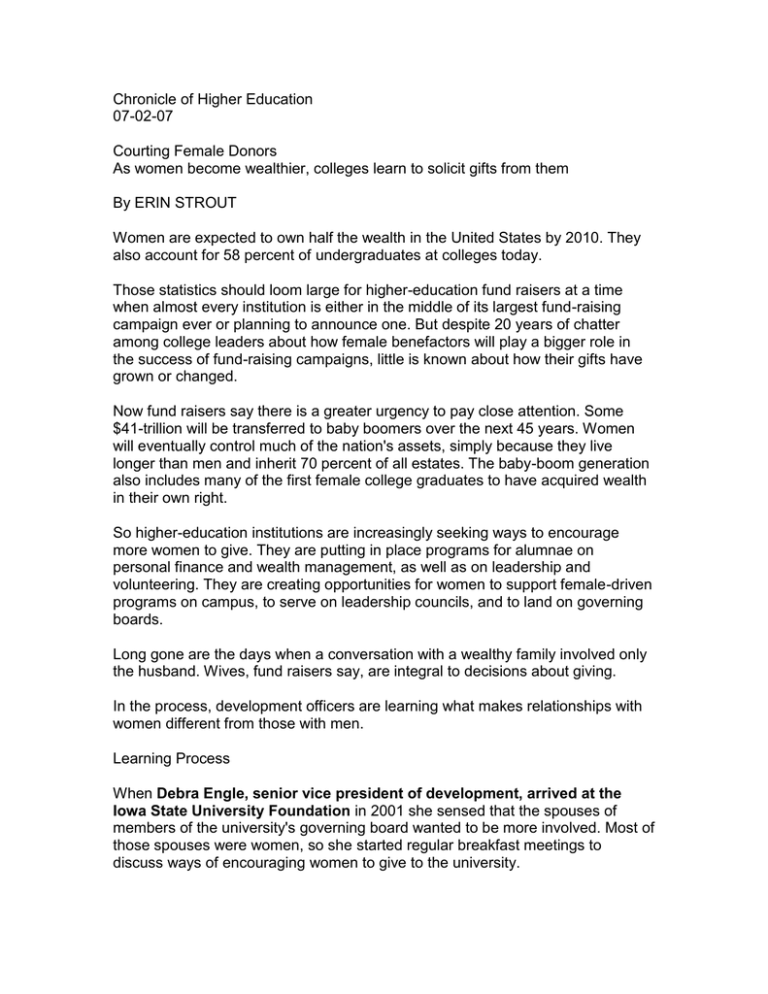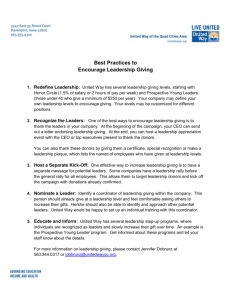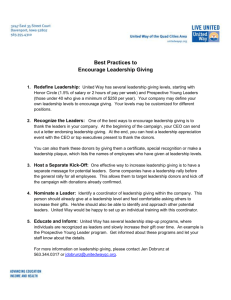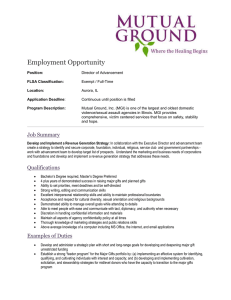Chronicle of Higher Education 07-02-07 Courting Female Donors
advertisement

Chronicle of Higher Education 07-02-07 Courting Female Donors As women become wealthier, colleges learn to solicit gifts from them By ERIN STROUT Women are expected to own half the wealth in the United States by 2010. They also account for 58 percent of undergraduates at colleges today. Those statistics should loom large for higher-education fund raisers at a time when almost every institution is either in the middle of its largest fund-raising campaign ever or planning to announce one. But despite 20 years of chatter among college leaders about how female benefactors will play a bigger role in the success of fund-raising campaigns, little is known about how their gifts have grown or changed. Now fund raisers say there is a greater urgency to pay close attention. Some $41-trillion will be transferred to baby boomers over the next 45 years. Women will eventually control much of the nation's assets, simply because they live longer than men and inherit 70 percent of all estates. The baby-boom generation also includes many of the first female college graduates to have acquired wealth in their own right. So higher-education institutions are increasingly seeking ways to encourage more women to give. They are putting in place programs for alumnae on personal finance and wealth management, as well as on leadership and volunteering. They are creating opportunities for women to support female-driven programs on campus, to serve on leadership councils, and to land on governing boards. Long gone are the days when a conversation with a wealthy family involved only the husband. Wives, fund raisers say, are integral to decisions about giving. In the process, development officers are learning what makes relationships with women different from those with men. Learning Process When Debra Engle, senior vice president of development, arrived at the Iowa State University Foundation in 2001 she sensed that the spouses of members of the university's governing board wanted to be more involved. Most of those spouses were women, so she started regular breakfast meetings to discuss ways of encouraging women to give to the university. The result was the Iowa State University Women & Philanthropy Committee, as well as regional programming focused on helping alumnae develop better financial acumen. "We knew that women could not be as philanthropic as their potential would allow if they didn't have a sense of their own financial status," Ms. Engle says. After two years of offering seminars in asset management, family-business succession planning, and estate planning, the educational programs have shifted in the last year to focus more on philanthropic planning, volunteering, and leadership. As the topics have evolved, attendance has increased. More than 300 women now regularly show up at the annual seminars. Iowa State's efforts are starting to show results. Since 2000, the number of female donors to the university has increased by 37 percent, to 22,438, and the total amount of money given to the university from women has increased 138 percent, to $25.8-million. And since 2003, the number of $100,000-plus gifts from women has increased by 50 percent (the number of gifts of the same size from men increased 42 percent in the same time period). One of those big donors is Ellen Molleston Walvoord, a 1961 graduate of Iowa State. Ms. Walvoord, who gave $1-million along with her husband, Tom, says it was important that fund raisers took the time to get to know her and asked her to take leadership positions on committees and boards before approaching her for money. Ms. Walvoord had a successful career in her own right (she was senior vice president at Abbott Laboratories when she retired), which she says helps her to control which charities her family supports. She pushed for a donation to the university's music departmentalthough her husband "didn't have much interest" in itshe says, because she had fond recollections of taking piano lessons at Iowa State while growing up in Ames. Ms. Engle is careful not to attribute the foundation's success with women only to programs and committees — she says that having more female development officers in the profession has also been important. And that is increasingly true, nationwide. The Association of Fundraising Professionals estimates that 66 percent of its membership is female. Perhaps as a result, Ms. Engle says, fund raisers now know more about how female donors respond to various kinds of solicitations and relationship building. For example, at Iowa State, female donors like being connected with faculty members and students who will be directly benefiting from their philanthropy, and they require information about long-term strategic plans before deciding to give. Transform or Preserve In many ways, female donors are different from male donors. Although donors of both sexes are more likely than in the past to want to support projects that have measurable results, women have always demanded assurances that their donations will transform an institution in some respect and have a broader impact on society. They do not usually have interest in recognition or bricks-and-mortar projects, fund raisers say. Co-ed institutions have learned from fund raisers at all-women's colleges, who have long known about women's different motivations. "We find that women still give anonymously far more frequently than men," says Patricia Jackson, vice president for advancement at Smith College. "They don't want the attention on themselves or for the public to know that they have the capacity." That, she says, makes it difficult to use the gifts inspire other women to donate. Ms. Jackson says that higher-education institutions find a lot of regional competition for their alumnae's financial support. Often, women feel pulled to give to their children's schools, local charities addressing women's issues, places of worship, and community foundations. To counter that, Smith has concentrated on making sure its alumnae have easy access, via the Web and other outlets, to how their gifts can affect the issues that they care about. For example, students tell potential donors how their research is helping battle diseases in developing counties, or how a project in the science and engineering department is having an impact on renewable fuel sources and sustainable living. Women's colleges have also worked hard to encourage donors to give through planned gifts, to be able to better forecast the college's financial future. Often women leave unexpected bequests, having waited for fear that they will run out of money. "Women see themselves as guardians of that money, instead of investors of it," Ms. Jackson says. "Women in general are more protective of their assets, not necessarily out of fear, but a sense of obligation to care for their children, in particular." Stefanie B. Valar, a member of Dartmouth College's first graduating class of women, the Class of 1976, and a fund raiser at Franklin & Marshall College, makes a gift to Dartmouth every year but says "the biggest will be through my will." Ms. Valar speculates that women's giving patterns are still influenced by taking time off from their careers to raise children or take care of aging parents. It is difficult to keep them connected to their colleges when they are overwhelmed with work and family obligations. But simple measures like making sure they receive periodic updates on organizations they were involved with on campus, connecting them to old friends in their local areas, or sending invitations to regional events that may be of special interest to women can go a long way toward establishing more valuable relationships. Ms. Jackson and other fund raisers believe a shift will eventually occur in the nature of women's donations. Those who graduated in the 1970s are into the third decade of their careers, and they may soon feel ready to give as they see fit. Already, women who have earned large sums of money have started to give it away in their lifetimes, and in a manner far different from how women have traditionally given to higher education. For instance, Meg Whitman, president and chief executive of eBay Inc., gave her alma mater, Princeton University, a $30million donation in 2002 for a residential college that bears her name. Following the Leaders In an attempt to inspire female donors, many colleges are creating high-profile alumnae advisory boards. One of the pioneers is the University of Pennsylvania, where the Trustees' Council of Penn Women is celebrating its 20th anniversary. The council, which has been replicated across the country, was created to increase involvement by alumnae. Susanna E. Lachs, chair of the council, as well as a trustee at Temple University, says that the professional women who graduated in the 1960s were making money, and the institution thought "it ought to be capitalizing on the power and networking capabilities of these women to support Penn." To become members of the council, women are invited and asked to give a minimum of $2,500 annually. Since the group's inception, its members have donated $173-million. Membership is limited to 170 women. The council supports the advancement of women's issues at the university, sponsoring career networking for women, female undergraduate scholarships, women's athletics, and professional-development for female faculty members. Twenty-nine women on the council have gone on to become trustees at Penn, and 67 others have become members of boards of overseers of individual colleges and centers at the university. That's no small feat considering that nationally, the percentage of female trustees has remained at about 29 percent since 1997, according to the Association of Governing Boards of Universities and Colleges. Getting women onto boards is an obvious way to encourage their giving at a higher level. John H. Zeller, vice president for development and alumni relations at Penn, says that groups like the council are a good way to engage women at the earliest stages of their giving. And the payoff, for the members and for Penn, goes beyond money. "This is a highly successful group," he says, "that has become a powerful force not only in philanthropy."






